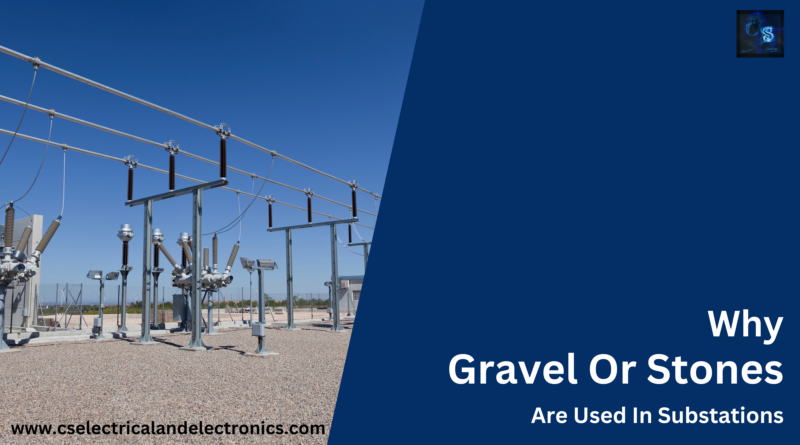Top 20 Reasons Why Gravel Or Stones Are Used In Substations
Hello guys, welcome back to our blog. Here in this article, we will discuss the top 20 reasons why gravel or stones are used in substations, how it is helpful, and what happens if stones are not used in substations.
If you have any electrical, electronics, and computer science doubts, then ask questions. You can also catch us on Instagram – CS Electrical & Electronics.
Also, read:
- Top 10 Electronic Starters Used In Electrical Motors, Latest Starters
- Top 20 Algorithms Electrical And Electronics Engineers Must Know
- What Is ECU In Vehicles, Electronic Control Unit, Purpose, Types
Why Gravel Or Stones Are Used In Substations
Because of their excellent resilience to weathering and erosion as well as their capacity to drain water away from the equipment, stones or crushed rock are frequently chosen as a material for the surface of a substation.
Transformers, switchgear, and other high-voltage devices are frequently found in substations together with other electrical equipment. These parts produce heat, and the rocks or stones act as a thermal barrier between the equipment and the ground to enable the heat to be dispersed and the equipment from being damaged.
Moreover, using rocks or stones as a surface material can lessen the likelihood of vegetation development and dry vegetation-related fires. Further reducing the possibility of electrical discharge or short circuits is the use of non-conductive materials.
Overall, the use of stones or crushed rock in substations is a practical and cost-effective solution that offers an electrical equipment surface that is strong and safe.
Top 20 Reasons Why Gravel Or Stones Are Used In Substations
20. Versatility:
Within the substation, stones can serve a number of functions, such as a surface material, a base layer for the equipment, or a drainage system. Because of its adaptability, it may be a sensible option for various substation designs and configurations.
19. Easy to replace:
If stones are damaged or worn out, they can be simply changed, which can lower the substation’s overall maintenance cost. This is crucial to guaranteeing the substation’s and its equipment’s long life.
18. Sound insulation:
Stones can offer some sound absorption, which can lessen noise pollution coming from the substation. This may be significant for substations close to populated areas or other noisy situations.
17. Vibration resistance:
Stones can offer a firm, vibration-resistant surface that can lengthen the life of the equipment and lessen the chance of equipment damage. Vibrations can be harmful to the equipment and can be brought on by a number of things, such as adjacent traffic or construction.
16. Fire resistance:
The equipment can have a fire-resistant surface made of stones, which lowers the risk of fire and the potential for fire propagation inside the substation. As fire can be a serious risk in a high-voltage setting, this is crucial for the safety of the workers and the equipment.
15. Availability:
Stones are a material that is frequently found, which can make it simpler to find and obtain the material for the substation. This is crucial for substations that are situated in difficult-to-access locations where there may not be easy access to supplies.
14. Flexibility:
Given that they can be shaped and arranged in a variety of ways to meet the needs of the substation, stones can be a flexible choice of surface material. The substation can more easily be designed and built to satisfy unique requirements because of this flexibility.
13. Environmental impact:
For substations located in environmentally sensitive areas, the fact that stones are a natural and environmentally beneficial material can be crucial. The substation’s environmental impact can be reduced by using natural materials.
12. Stability:
The risk of movement or moving of the equipment is decreased by the firm and solid surface that stones offer. This is crucial for the security of the workers and the machinery, as movement or shifting might harm the machinery or put workers at risk of harm.
11. Resistance to corrosion:
Stones have a strong corrosion resistance, which is beneficial for substations near water or in humid environments. The equipment and surface material of the substation may suffer from the corrosive effects of saltwater or high humidity.
10: High resistance to weathering and erosion:
Stones provide a strong and long-lasting surface for the substation equipment since they can endure the impacts of weather and erosion. To stop deterioration and damage to the electrical equipment, the surface material of a substation needs to be able to withstand the effects of wind, rain, and other external elements.
09. Thermal stability:
Since stones are resistant to weather and erosion, the substation equipment will have a sturdy and long-lasting surface. In order to stop deterioration and damage to the electrical equipment, the surface material of a substation needs to be able to withstand the effects of wind, rain, and other external elements.
08. Drainage:
Excellent drainage can be achieved with stones, which lowers the possibility of water accumulating around machinery. With high-voltage equipment, water can pose a serious risk, so it’s crucial to make sure the surface material allows for effective drainage.
07. Non-conductive material:
Because stones are non-conductive, the chance of an electrical discharge or short circuit is reduced. Due to the high potential of injury or equipment damage presented by electrical discharges or short circuits, this is crucial for safety reasons.
06. Reduced risk of vegetation growth:
Stones can aid in preventing the development of vegetation around the apparatus, which could provide a fire risk and complicate maintenance. It’s crucial to prevent the growth of vegetation around the equipment since it increases the risk of electrical discharge or short circuits.
05. Accessibility:
Stones make it simpler to reach the machinery and carry out upkeep and repairs. It could be challenging to reach the equipment and carry out maintenance and repairs if the surface is too flimsy or unsteady.
04. Cost-effective:
Stones are often less expensive to utilize as a surface material than other materials like concrete. It may be a sensible option for substations as a result, particularly for big installations where cost may be a major consideration.
03. Aesthetic appeal:
The natural appearance and blending with the surroundings that stones can offer are appealing. For substations situated in areas with significant aesthetic or environmental value, this is crucial.
02. Low maintenance:
Stones are a suitable option for substations since they require less maintenance. This is crucial for lowering the substation’s overall maintenance costs.
01. Compliance with regulations
Regulations and standards frequently call for the usage of stones in substations to guarantee the security and dependability of the electrical power supply. The reliability of the electrical power system as well as the safety of the staff and the general public depend on adherence to these requirements.
This was about “Why Gravel Or Stones Are Used In Substations“. I hope this article may help you all a lot. Thanks for reading.
Also, read:
- 10 Tips To Maintain Battery For Long Life, Battery Maintainance
- 10 Tips To Save Electricity Bills, Save Money By Saving Electricity
- 100 (AI) Artificial Intelligence Applications In The Automotive Industry
- 100 + Electrical Engineering Projects For Students, Engineers
- 1000+ Control System Quiz, Top MCQ On Control System
- 1000+ Electrical Machines Quiz, Top MCQs On Electrical Machines
- 1000+ Electronics Projects For Engineers, Diploma, MTech Students
- 1000+ MATLAB Simulink Projects For MTech, Engineering Students
Author Profile
- Chetu
- Interest's ~ Engineering | Entrepreneurship | Politics | History | Travelling | Content Writing | Technology | Cooking
Latest entries
 All PostsApril 19, 2024What Is Vector CANoe Tool, Why It Is Used In The Automotive Industry
All PostsApril 19, 2024What Is Vector CANoe Tool, Why It Is Used In The Automotive Industry All PostsApril 13, 2024What Is TCM, Transmission Control Module, Working, Purpose,
All PostsApril 13, 2024What Is TCM, Transmission Control Module, Working, Purpose, All PostsApril 12, 2024Top 100 HiL hardware in loop Interview Questions With Answers For Engineers
All PostsApril 12, 2024Top 100 HiL hardware in loop Interview Questions With Answers For Engineers All PostsMarch 22, 2024Driver Monitoring Systems In Vehicles, Working, Driver Sleepy Alert
All PostsMarch 22, 2024Driver Monitoring Systems In Vehicles, Working, Driver Sleepy Alert








